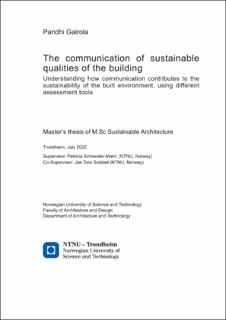| dc.contributor.advisor | Schneider-Marin, Patricia | |
| dc.contributor.advisor | Solstad, Jan Tore | |
| dc.contributor.author | Gairola, Paridhi | |
| dc.date.accessioned | 2022-07-20T17:20:19Z | |
| dc.date.available | 2022-07-20T17:20:19Z | |
| dc.date.issued | 2022 | |
| dc.identifier | no.ntnu:inspera:113132537:64524114 | |
| dc.identifier.uri | https://hdl.handle.net/11250/3007380 | |
| dc.description.abstract | Med økende bekymring for klimaendringer og begrensede ressurser, har byggebransjen tilpasset seg konseptet bærekraft. Gitt grønne byggs betydning for samfunn og miljø, øker det et behov for å spre bevissthet og kunnskap om sektoren på en transparent og kortfattet måte.
Oppgaven tar for seg behovet for kommunikasjon i bærekraftig bygg, og hvordan det fremmer bærekraftig ytelse og interessentengasjement. Konkret undersøker den hvordan noen av de eksisterende bærekraftige vurderingsmetodene hjelper denne kommunikasjonen ved å sammenligne dem med hverandre.
Dette gjøres ved å bruke to bærekraftige vurderingsverktøy på en casestudie og evaluere resultatene basert på litteratur og en eksperimentell undersøkelse. For å sikre at vurderingsverktøyene ble analysert i dybden, ble omfanget begrenset til enkelte parametere som passet til norsk kontekst.
Det er observert at bærekraftsvurderingsmetodene forbedrer den generelle bærekraftige ytelsen til bygningen. Selv om graden av denne påvirkningen ikke kunne utledes fra studien, ga resultatene nok data til å forstå deres innvirkning på beslutningsprosessen. Mens Environmental Cost Indicator målte den økonomiske verdien av Global Warming Potential, presenterte BREEAM-NOR (BRE Globals miljøvurderingsmetode, tilpasset norsk kontekst) en poengsum, i prosent, for å forstå potensiell reduksjon av GWP. Det er derfor vanskelig å velge ett bestemt vurderingsverktøy som en bedre metode, siden de kommuniserer annerledes til interessenter basert på deres interesser og ansvar. | |
| dc.description.abstract | With growing concerns over climate change and finite resources, the construction industry has adapted to the concept of sustainability. Given the significance of green buildings on society and the environment, there rises a need to disseminate awareness and knowledge about the sector in a transparent and concise manner.
The thesis addresses the need for communication in sustainable building, and how it fosters sustainable performance and stakeholder engagement. Specifically, it investigates how some of the existing sustainable assessment methods assist this communication by comparing them with each other.
This is done by applying two sustainable assessment tools to a case study and evaluating the results based on literature and an experimental survey. To ensure that the assessment tools were analysed in-depth, the scope was restrained to certain parameters that suited the Norwegian context.
It is observed that the sustainability assessment methods do improve the overall sustainable performance of the building. Although the degree of this influence could not be deduced from the study, the results provided enough data to understand their impact on the decision-making process. While the Environmental Cost Indicator gauged the monetary value of the Global Warming Potential, BREEAM-NOR (BRE Global’s environmental assessment method, adapted to the Norwegian context) presented a score, in percentage, to understand the potential reduction of GWP. Thus, it is hard to pick one particular assessment tool as a better method, since they communicate differently to stakeholders based on their interests and responsibilities. | |
| dc.language | eng | |
| dc.publisher | NTNU | |
| dc.title | The communication of sustainable qualities of the building | |
| dc.type | Master thesis | |
